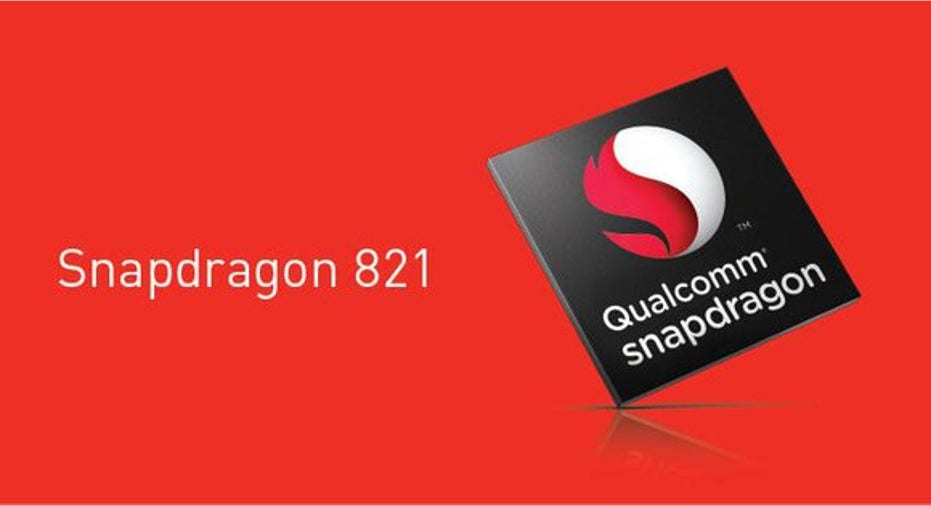Does the Snapdragon 821 Signal What Lies Ahead for Qualcomm Inc?

Image source: Qualcomm.
Earlier this year, wireless chip specialist Qualcomm (NASDAQ: QCOM) released its Snapdragon 820 processor. The 820 was well-received and won the company a place inside theSamsung(NASDAQOTH: SSNLF) Galaxy S7 and Note 7 flagship smartphones, an important recovery as the prior-generation Snapdragon 810 processor failed to make it into the Samsung Galaxy S6 and Note 5 releases.
Interestingly, shortly after the Snapdragon 820 began shipping in devices, Qualcomm went ahead and announced a higher-end variant known as the Snapdragon 821 (not so much a "successor" since Qualcomm indicated that it will ship both the 820 and 821 simultaneously).
Let's take a look at what the 821 brings to the table and what Qualcomm hopes to achieve with this latest release.
Same processor, now with faster clock speeds
The Snapdragon 821 appears to share the same basic architectural design as the Snapdragon 820. Given the length of chip development cycles, it would be unrealistic to expect a substantial design change in a product released so soon after the latest generation.
That said, the Snapdragon 821 runs its processor cores and graphics engine at higher frequencies, which should lead to increased performance. AnandTech says that the Snapdragon 820 runs its high-performance processor cores at 2.15GHz and its lower-performance processor cores at 1.59GHz. The Snapdragon 821, on the other hand, bumps the former up to 2.34GHz and the latter to 2.19GHz. The graphics processor sees a boost in frequency from 624 MHz to 653 MHz as well.
These improvements in the speed of the processor cores should help overall performance, including web surfing and app usage. The graphics boost should make games and other graphically intensive applications like virtual reality run more smoothly.
The beginning of more aggressive product segmentation for Qualcomm?
It would appear that Qualcomm is trying to get more aggressive about segmenting its product lines in a bid to improve its average selling prices and, ultimately, profitability.
Qualcomm already categorizes its products broadly by tiers (i.e., Snapdragon 200-series for entry-level phones, Snapdragon 400-series for mid-range, Snapdragon 600-series for high-end, and Snapdragon 800-series for "premium" phones), but I think it could benefit from additional segments within those tiers.By releasing the Snapdragon 821, Qualcomm is offering potential customers the opportunity to pay a bit more to get even stronger performance.
For some customers such as Samsung,that premium clearly wasn't worth it. Samsung's new Galaxy Note 7, for example, doesn't feature the Snapdragon 821 but the older Snapdragon 820. Companies with significant brand power, like Samsung, probably don't see the value in paying more for a marketing point that will likely be ignored by the vast majority of their customers.
However, it's worth noting that ASUSTek, a company well-known in the personal computer market but less so for smartphones, is adopting the Snapdragon 821 in its ZenFone 3 family of products. Since ASUSTek doesn't have anywhere close to the recognition of a brand like Samsung, it's probably hoping that the use of the latest Snapdragon 821 might help its products appeal more to customers.
A secret billion-dollar stock opportunity The world's biggest tech company forgot to show you something, but a few Wall Street analysts and the Fool didn't miss a beat: There's a small company that's powering their brand-new gadgets and the coming revolution in technology. And we think its stock price has nearly unlimited room to run for early in-the-know investors! To be one of them, just click here.
Ashraf Eassa owns shares of Qualcomm. The Motley Fool owns shares of and recommends Qualcomm. Try any of our Foolish newsletter services free for 30 days. We Fools may not all hold the same opinions, but we all believe that considering a diverse range of insights makes us better investors. The Motley Fool has a disclosure policy.